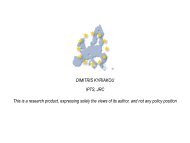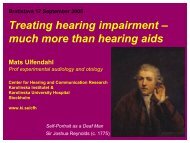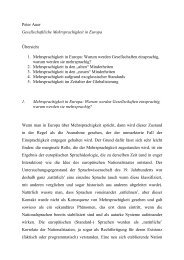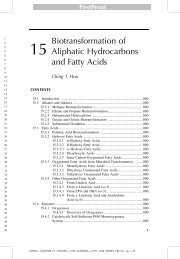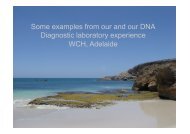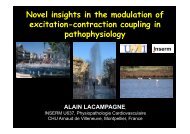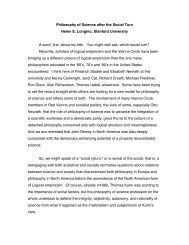colonies
colonies
colonies
Create successful ePaper yourself
Turn your PDF publications into a flip-book with our unique Google optimized e-Paper software.
Multicellular microorganisms
Bacteria<br />
Slime moulds<br />
Yeasts<br />
Dennis Kunkel<br />
Dennis Kunkel<br />
Classical paradigm of microbiology<br />
(cited in Shapiro and Dworkin, 1997)<br />
“bacteria as single cells”<br />
“bacteria as isolated, small,<br />
primitive organisms with a limited<br />
repertoire of automatic responses<br />
to changing conditions”<br />
• Robert Koch
Microorganisms in laboratories<br />
Bacteria<br />
Yeasts<br />
Slime<br />
moulds<br />
Dennis Kunkel<br />
Optimal conditions:<br />
• nutrients (continual feeding)<br />
• temperature<br />
• humidity<br />
• Individual cells<br />
• Exponentially growing pure<br />
cultures<br />
X Microorganisms in nature
Physarum polycephalum D.discoideum<br />
Microorganisms in Nature<br />
• Predominantly exist in multicellular communities<br />
Fruiting bodies of slime moulds<br />
Fruiting bodies of Myxobacteriae<br />
Chondromyces crocatus Stigmatella aurantiaca<br />
National Geographic, 1981<br />
Petr Folk<br />
Dale Kaiser<br />
H.U. Schairer<br />
Colonies<br />
Bacteria<br />
Yeast<br />
Stalks<br />
Biofilms<br />
E. Ben-Jacob, H.Levine, 1998<br />
Engelberg et al.,1998
Physarum polycephalum D.discoideum<br />
Microorganisms in Nature<br />
• Predominantly exist in multicellular communities<br />
Fruiting bodies of slime moulds<br />
Fruiting bodies of Myxobacteriae<br />
Chondromyces crocatus Stigmatella aurantiaca<br />
National Geographic, 1981<br />
Petr Folk<br />
Dale Kaiser<br />
H.U. Schairer<br />
Colonies<br />
Bacteria<br />
Yeast<br />
Stalks<br />
Biofilms<br />
E. Ben-Jacob, H.Levine, 1998<br />
Engelberg et al.,1998
Biofilms<br />
Important – contamination of the surfaces (medical care, industry) etc.<br />
Problem of cultivation under laboratory conditions: laboratory x natural biofilm<br />
Pseudomonas aeruginosa biofilm (Yasuda,Trends Glycosci. Glycotechnol. 8: 409-417, 1996)<br />
Candida albicans biofilm (Andes et al., Infect Immun. 72: 6023-31, 2004)
Understanding of mechanisms of microbial interactions<br />
and relationship within a community.<br />
Short-range and long-range signalling, adaptation<br />
Cell-cell interactions, extracellular molecules (small)<br />
„quorum sensing“ – monitoring of cell density and a response of the<br />
whole population<br />
Extracellular matrix formation<br />
Proteins and sugars<br />
Resistance of the structure against an environmental impact<br />
Differentiation, specialization and cooperation of the cells<br />
Nutrient processing<br />
Dying of the part of the population – altruistic-like behaviour (profitable<br />
for the whole population)<br />
MODEL SYSTEMS<br />
(usually single-species) forming multicellular populations
Physarum polycephalum D.discoideum<br />
Microorganisms in Nature<br />
• Predominantly exist in multicellular communities<br />
Fruiting bodies of slime moulds<br />
Fruiting bodies of Myxobacteriae<br />
Chondromyces crocatus Stigmatella aurantiaca<br />
National Geographic, 1981<br />
Petr Folk<br />
Dale Kaiser<br />
H.U. Schairer<br />
Colonies<br />
Bacteria<br />
Yeast<br />
Stalks<br />
Biofilms<br />
E. Ben-Jacob, H.Levine, 1998<br />
Engelberg et al.,1998
Yeast stalks<br />
Engelberg et al.,<br />
J.Bacteriol. 180:<br />
3992-6 (1998)<br />
Scherz et al.,<br />
J.Bacteriol. 183:<br />
5402-13 (2001)<br />
Anatomical analysis<br />
• CORE<br />
• SHELL<br />
Cell composition analysis - cell differentiation<br />
• Dying and<br />
dead cells<br />
• Cells<br />
with<br />
spores
Differentiated gene expression within <strong>colonies</strong><br />
Saccharomyces cerevisiae promoter library<br />
ATG<br />
LacZ gene<br />
Fragment of yeast<br />
genomic DNA<br />
CCR4p-LacZ<br />
Mináriková et al. (2001)<br />
Exp.Cell Res. 271: 296-304<br />
Parental strain<br />
ccr4 mutant
Cells within various multicellular structures<br />
Fruiting bodies<br />
• Can differentiate into “specialised” cell<br />
variants (e.g. resistant spores).<br />
• Can interact, communicate and synchronise<br />
their development. Can better adapt to<br />
changed environment.<br />
• Exhibit altruistic-like behaviour (programmed<br />
cell-lysis).<br />
• Better protected against environment<br />
Life within a community<br />
Yeast <strong>colonies</strong><br />
• Offers possibilities for development and<br />
survival that are ruled out in individual cells<br />
• Profit of an individual can be subordinated<br />
to that of the community
Cells within multicellular structures<br />
Fruiting bodies<br />
• Can differentiate into “specialised” cell<br />
variants (e.g. resistant spores).<br />
• Can interact, communicate and synchronise<br />
their development. Can better adapt to<br />
changed environment.<br />
• Exhibit altruistic-like behaviour (programmed<br />
cell-lysis).<br />
• Better protected against environment<br />
Populations X Solitary microorganisms<br />
Existence of processes specific for<br />
<br />
multicellular structures<br />
<br />
Yeast <strong>colonies</strong><br />
Important for long-term survival of yeast<br />
<br />
population (in a colony)
Yeast Colony Group<br />
http://www.natur.cuni.cz/~zdenap/<br />
Department of Genetics and Microbiology, Charles<br />
University, Prague<br />
Cell biology and physiology of multicellular yeast<br />
communities (<strong>colonies</strong>)<br />
Institute of Microbiology ASCR<br />
Prague<br />
Libuše Váchová et al.
1<br />
Multicellular populations interact, communicate,<br />
synchronise their development and adapt to changed<br />
environment<br />
Volatile AMMONIA functions as a long-range<br />
signal in yeast <strong>colonies</strong><br />
Nature 390: 532-536, 1997<br />
J. Cell Sci. 113: 1923-1928, 2000<br />
BBRC 294: 962-967, 2002
AMMONIA :<br />
2<br />
Produced in pulses<br />
NH 3<br />
NH 3<br />
NH 3<br />
ACIDIC<br />
ACIDIC<br />
ALKALI<br />
ALKALI<br />
ALKALI<br />
3<br />
Production is amplified between neighbouring <strong>colonies</strong><br />
and it results in their asymmetric growth inhibition.<br />
MM+CA<br />
Candida mogii<br />
MM<br />
Ammonia<br />
production<br />
No ammonia<br />
production<br />
4<br />
Ammonia production is dependent on uptake and metabolism<br />
of amino acids and is not dependent on uptake<br />
and concentration of extracellular ammonium NH 4+ .
Candida mogii<br />
NH 3<br />
NH 3<br />
5 Yeast <strong>colonies</strong> synchronise their ammonia pulses and,<br />
consequently, their development.
Candida mogii<br />
Ammonia
Candida mogii<br />
NH 3<br />
NH 3<br />
6<br />
Active molecule in yeast <strong>colonies</strong> is neither NH 4+ , nor<br />
alkali itself, but unprotonated ammonia.
MODEL<br />
Cytoplasm<br />
Vacuole<br />
NH 3<br />
Diffusion<br />
NH 3 NH<br />
+<br />
4<br />
Nucleus<br />
Dissipation of H + gradient<br />
between vacuole and cytoplasm<br />
Other volatile amines<br />
Signal <br />
Changes of the cell<br />
behaviour
Saccharomyces cerevisiae<br />
ALKALI ALKALI<br />
NH 3 ACIDIC NH 3 ACIDIC<br />
7 day 12 day<br />
Kinetics<br />
1<br />
NH 3<br />
2 3 4 5 6<br />
ACIDIC ALKALI<br />
Transition<br />
COLONIES<br />
• more than one week old<br />
• stationary-like cells<br />
LEU1<br />
AAT1<br />
LYS9<br />
HIS4<br />
GCV1<br />
SHM2<br />
MET10<br />
HIS5<br />
SRY1<br />
HOM2<br />
ARO8<br />
ARG1<br />
ARG5,6<br />
ARG4<br />
STR3<br />
SAM2<br />
UGA1<br />
CHA1<br />
SER3<br />
BIO5<br />
DUR3<br />
HNM1<br />
THI4<br />
ADE5,7<br />
ADE12<br />
ADE13<br />
ADE1<br />
RNR2<br />
RNR4<br />
CDC21<br />
URA1<br />
URA10<br />
YNK1<br />
ZRT1<br />
SUL1<br />
SUL2<br />
PHO89<br />
PHO84<br />
ATO1<br />
ATO2<br />
A TO3<br />
Microarray analyses of<br />
gene expression changes<br />
(C.Jacq laboratory, ECNS,<br />
Paris)<br />
Metabolism Transport Metabolism<br />
Ions<br />
Amino acids Nucleotides Transport of inorg<br />
YJR120w<br />
OM45<br />
COX5A<br />
CYC7<br />
QCR2<br />
CYC1<br />
COX9<br />
ATP2<br />
ATP15<br />
COX13<br />
QCR9<br />
COX4<br />
COR1<br />
QCR7<br />
COX12<br />
NDI1<br />
CCP1<br />
YJL045w<br />
HEM12<br />
POR1<br />
MIR1<br />
YER053c<br />
TIM17<br />
PET9<br />
AAC3<br />
SFC1<br />
ODC1<br />
OAC1<br />
ACO1<br />
SDH1<br />
KGD1<br />
ID H 1<br />
ID H 2<br />
MDH1<br />
FUM1<br />
CIT3<br />
ALD4<br />
ACS1<br />
IC L 2<br />
AAT1<br />
CAT2<br />
ALD5<br />
Oxidative phosphorylation Transport<br />
Citrate cycle<br />
Other<br />
enzymes<br />
Carbon metabolism and mitochondria function<br />
YER067w<br />
FIT2<br />
GPH1<br />
OM45<br />
GLC3<br />
UBC8<br />
HSP30<br />
POR1<br />
CYC7<br />
RPM2<br />
YOL155c<br />
YNL134c<br />
CTT1<br />
ECM4<br />
YGP1<br />
SPI1<br />
YER053c<br />
YRO2<br />
CCP1<br />
CWP2<br />
SED1<br />
SOD1<br />
HSP12<br />
DDR48<br />
YJL144w<br />
UGA1<br />
IC Y 1<br />
NCE103<br />
YOL155c<br />
ECM4<br />
SCW 4<br />
ECM13<br />
DDR48<br />
SSR1<br />
CWP2<br />
SED1<br />
YLR110c<br />
CRS5<br />
SRL1<br />
YHB1<br />
MLF3<br />
Environmental stress response (ESR) Cell wall Resista<br />
YLR004c<br />
YOL119c<br />
YDL218w<br />
YHR095w<br />
YKR040c<br />
YGR069w<br />
YNL179c<br />
YPL025c<br />
YDR504c<br />
YOR385w<br />
YAL018c<br />
YLR194c<br />
YNL143c<br />
ATO1<br />
YIL057c<br />
ATO2<br />
YCLX11w<br />
YDR223w<br />
ATO3<br />
YPL113c<br />
YOR338w<br />
YPR151c<br />
YOR306c<br />
YPL201c<br />
YGR161c<br />
YMR018w<br />
YLR414c<br />
YPL276w<br />
YDL223c<br />
YIL059c<br />
IC Y 1<br />
YGR250c<br />
YJL045w<br />
YOR273c<br />
YLR460c<br />
YPR156c<br />
YNL228w<br />
YJL144w<br />
MRH1<br />
YLR168c<br />
YER001w<br />
Palková et al. (2002) Mol. Biol. Cell. 13: 3901-3914<br />
Palková & Váchová (2003) Int. Rev. Cytol. 225: 229-272<br />
Unknown<br />
5<br />
Transition of <strong>colonies</strong> to the ammonia producing period of<br />
their development is accompanied by reprogramming of<br />
their metabolism.
1. Identification of new putative ammonium exporters<br />
ACID<br />
ALKALI<br />
NH 3<br />
Ycr010c, Ydr384c and Ynr002c PROTEINS:<br />
• HOMOLOGOUS<br />
• LOCALISED ON A MEMBRANE<br />
Plasma membrane<br />
localisation of<br />
Ycr010p-GFP<br />
~ 10<br />
~ 10<br />
~ 5<br />
1<br />
2 3 4 5 6<br />
YCR010c<br />
YDR384c<br />
YNR002c<br />
• FUNCTION UNKNOWN<br />
A. Protein sequence analyses data<br />
B. Experimental data<br />
YDR384c<br />
YCR010c<br />
Ammonium Transport Outwards<br />
ATO1 ATO2 ATO3<br />
• Large group of proteins related to S.cerevisiae Ato’s among bacteria, archae,<br />
yeast and other eukaryotes (Leishmania, Chlamydomonas)
1 Ato-GFP proteins associate with membrane raft microdomains.<br />
Ato1p-GFP and Ato3p-GFP localise to raft patches.<br />
Ato1p-GFP<br />
Ato3p-GFP<br />
Confocal microscopy<br />
1<br />
2<br />
1<br />
1 2<br />
1 2 3 4 5 6<br />
Ato1p-GFP<br />
Extraction, fractionation and PAGE<br />
2 Ato1p-GFP<br />
localisation to raft<br />
patches is<br />
pH-dependent.<br />
TV<br />
TG<br />
H 2<br />
O<br />
pH 5 pH 8<br />
5 30 50 5 35 60 min<br />
3 Production of Ato-GFP proteins is induced by ammonia.<br />
Řičicová et al., BBA-Biomembranes 1768: 1170-1178 (2007)
LEU1<br />
AAT1<br />
LYS9<br />
HIS4<br />
GCV1<br />
SHM2<br />
MET10<br />
HIS5<br />
SRY1<br />
HOM2<br />
ARO8<br />
ARG1<br />
ARG5,6<br />
ARG4<br />
STR3<br />
SAM2<br />
UGA1<br />
CHA1<br />
SER3<br />
BIO5<br />
DUR3<br />
HNM1<br />
THI4<br />
ADE5,7<br />
ADE12<br />
ADE13<br />
ADE1<br />
RNR2<br />
RNR4<br />
CDC21<br />
URA1<br />
URA10<br />
YNK1<br />
ZRT1<br />
SUL1<br />
SUL2<br />
PHO89<br />
PHO84<br />
ATO1<br />
ATO2<br />
ATO3<br />
MEP2<br />
FRE7<br />
CTR1<br />
PMP1<br />
PMA2<br />
PMA1<br />
YLR004c<br />
YOL119c<br />
YOR306c<br />
JEN1<br />
SEO1<br />
YOR273c<br />
TPO1<br />
YIL121w<br />
YGR138c<br />
YPR156c<br />
HXT1<br />
HXT9<br />
HXT3<br />
HXT12<br />
HXT4<br />
HXT8<br />
HXT6<br />
HXT7<br />
STL1<br />
RPL19B<br />
RPL23A<br />
RPL32<br />
ACT1<br />
MODEL<br />
Metabolism Transport Metabolism<br />
Ions Protons<br />
Carboxylic<br />
acids MFS-MDR Hexoses<br />
Controls<br />
Microarray data<br />
Amino acids Nucleotides Transport of inorganic compounds<br />
Transport of organic compounds and drugs<br />
YJR120w<br />
OM45<br />
COX5A<br />
CYC7<br />
QCR2<br />
CYC1<br />
COX9<br />
ATP2<br />
ATP15<br />
COX13<br />
QCR9<br />
COX4<br />
COR1<br />
QCR7<br />
COX12<br />
NDI1<br />
CCP1<br />
YJL045w<br />
HEM12<br />
POR1<br />
MIR1<br />
YER053c<br />
TIM17<br />
PET9<br />
AAC3<br />
SFC1<br />
ODC1<br />
OAC1<br />
ACO1<br />
SDH1<br />
KGD1<br />
IDH1<br />
IDH2<br />
MDH1<br />
FUM1<br />
CIT3<br />
ALD4<br />
ACS1<br />
ICL2<br />
AAT1<br />
CAT2<br />
ALD5<br />
YOL155c<br />
DAL7<br />
PCK1<br />
FBP1<br />
MLS1<br />
ICL1<br />
MDH2<br />
GPM2<br />
GPM1<br />
FDH1<br />
ADH2<br />
PDH1<br />
ADH1<br />
IDP3<br />
CTA1<br />
ACS1<br />
POX1<br />
POT1<br />
FOX2<br />
CAT2<br />
ECI1<br />
FAA2<br />
DCI1<br />
YMR018w<br />
PEX11<br />
PXA1<br />
PXA2<br />
ERG6<br />
ERG25<br />
PDR16<br />
ACH1<br />
HNM1<br />
OPI3<br />
INO1<br />
SCS7<br />
Oxidative phosphorylation Transport<br />
Citrate cycle<br />
Other<br />
enzymes<br />
Glyoxylate /<br />
Gluconeogenesis<br />
Glycolysis /<br />
Others<br />
Fatty acids<br />
Inositol<br />
Carbon metabolism and mitochondria function<br />
Carbon metabolism in cytoplasm<br />
Peroxisome function<br />
Lipids<br />
YER067w<br />
FIT2<br />
GPH1<br />
OM45<br />
GLC3<br />
UBC8<br />
HSP30<br />
POR1<br />
CYC7<br />
RPM2<br />
YOL155c<br />
YNL134c<br />
CTT1<br />
ECM4<br />
YGP1<br />
SPI1<br />
YER053c<br />
YRO2<br />
CCP1<br />
CWP2<br />
SED1<br />
SOD1<br />
HSP12<br />
DDR48<br />
YJL144w<br />
UGA1<br />
ICY1<br />
NCE103<br />
YOL155c<br />
ECM4<br />
SCW4<br />
ECM13<br />
DDR48<br />
SSR1<br />
CWP2<br />
SED1<br />
YLR110c<br />
CRS5<br />
SRL1<br />
YHB1<br />
MLF3<br />
PDR16<br />
ICS2<br />
NCA3<br />
UTH1<br />
IME1<br />
TIS11<br />
DIA1<br />
SPP41<br />
ROX1<br />
MSN4<br />
CAT8<br />
BOP2<br />
CMK2<br />
YPK2<br />
BAG7<br />
GLC7<br />
RCK2<br />
DMC1<br />
UBP13<br />
MNN1<br />
Environmental stress response (ESR) Cell wall Resistance<br />
Aging Transcription Signalling Miscellaneous<br />
Regulation<br />
YLR004c<br />
YOL119c<br />
YDL218w<br />
YHR095w<br />
YKR040c<br />
YGR069w<br />
YNL179c<br />
YPL025c<br />
YDR504c<br />
YOR385w<br />
YAL018c<br />
YLR194c<br />
YNL143c<br />
ATO1<br />
YIL057c<br />
ATO2<br />
YCLX11w<br />
YDR223w<br />
ATO3<br />
YPL113c<br />
YOR338w<br />
YPR151c<br />
YOR306c<br />
YPL201c<br />
YGR161c<br />
YMR018w<br />
YLR414c<br />
YPL276w<br />
YDL223c<br />
YIL059c<br />
ICY1<br />
YGR250c<br />
YJL045w<br />
YOR273c<br />
YLR460c<br />
YPR156c<br />
YNL228w<br />
YJL144w<br />
MRH1<br />
YLR168c<br />
YER001w<br />
YPR127w<br />
YLR110c<br />
PRY2<br />
PRY1<br />
YGR138c<br />
YPR123c<br />
YOR049c<br />
YIL121w<br />
YKL044w<br />
YOR135c<br />
YER053c<br />
YPL095c<br />
YNL134c<br />
YNL190w<br />
YOL155c<br />
YBL048w<br />
YOL101c<br />
YJR120w<br />
FIT2<br />
YER067w<br />
/6 /4 /2 /1.5 1 X 1.5 X 2 X 4 X 6<br />
Possible metabolic changes during<br />
acid-to-alkali colony transition<br />
Unknown<br />
Model supplemented and elaborated<br />
- additional methodical approaches<br />
Catalase activity (U/mg)<br />
30<br />
25<br />
20<br />
15<br />
10<br />
5<br />
0<br />
Cta1p<br />
Ctt1p<br />
Cta1p<br />
Ctt1p<br />
cytosolic catalase Ctt1p<br />
peroxisomal catalase Cta1p<br />
S3 S5 S7 S9 S12 S14 SF6 SF7 S19 S21 S25 S28 S32<br />
Superoxide dismutase activity (U/mg)<br />
2<br />
1<br />
0<br />
Sod1p<br />
Western blots<br />
cytosolic superoxide dismutase Sod1p<br />
S3 S5 S7 S9 S12 S14 SF6 SF7 S19 S21 S25 S28 S32<br />
Measurement of enzymatic activities<br />
Monitoring of intracellular amino acid<br />
concentrations<br />
Cytological analyses<br />
Pma1p<br />
[%]<br />
100<br />
90<br />
80<br />
70<br />
60<br />
50<br />
40<br />
30<br />
3 6 10 13 17 22 26 31 d<br />
Pma1p<br />
Pma1p ATPase activity<br />
5 12 19 d<br />
BY4742<br />
20<br />
0 5 10 15 [days] 20<br />
nmol/g wet weight<br />
nmol/g wet weight<br />
nmol/g wet weight<br />
1600<br />
1400<br />
1200<br />
1000<br />
800<br />
600<br />
400<br />
200<br />
0<br />
350<br />
300<br />
250<br />
200<br />
150<br />
100<br />
50<br />
3500<br />
3000<br />
2500<br />
2000<br />
1500<br />
1000<br />
BY4742<br />
sok2<br />
ARGININE<br />
0 5 10 15 20 25 30 [d]<br />
BY4742<br />
sok2<br />
GLUTAMINE<br />
0<br />
0 5 10 15 20 25 30[d]<br />
500<br />
0<br />
BY4742<br />
sok2<br />
ALANINE<br />
0 5 10 15 20 25 30[d]
MODEL<br />
Acidic<br />
pH<br />
Reactive oxygen<br />
species<br />
ROS<br />
ESR<br />
Environmental stress response genes, including<br />
genes encoding stress defence enzymes<br />
(catalase, superoxide dismutase).<br />
TCA<br />
Nutrient limitation<br />
Active<br />
mitochondria<br />
(oxidative<br />
phosphorylation)<br />
ATP ADP<br />
Pma1p<br />
H +<br />
H + ATPase<br />
Stressed cells<br />
(acidic phase)
MODEL<br />
Acidic<br />
pH<br />
pH<br />
Alkali<br />
Production of Ato proteins,<br />
ammonium exporters<br />
TCA<br />
Active<br />
ROS<br />
Stressed cells<br />
(acidic phase)<br />
ESR<br />
H + ATPase function is diminished<br />
Switch to glyoxylate cycle<br />
AcetylCoA from peroxisomes<br />
Oxalacetate from amino acid<br />
metabolism<br />
Gradual<br />
ATP<br />
mitochondria repression of mitochondrial ADP<br />
functions (oxidative (oxidative phosphorylation,<br />
some enzymes of the citrate H + ATPase cycle).<br />
H +<br />
phosphorylation)<br />
Nutrient limitation<br />
GC<br />
TCA<br />
TCA<br />
H<br />
+<br />
ATPase<br />
Ato<br />
NH<br />
+<br />
4<br />
NH + H + 3<br />
pH<br />
ROS<br />
Oxalac<br />
Glyoxalate<br />
cycle<br />
H +<br />
ESR<br />
Acetyl<br />
CoA<br />
AA met<br />
β-ox<br />
fatty acids<br />
PX
MODEL<br />
Acidic<br />
pH<br />
pH<br />
Alkali<br />
Production of Ato proteins,<br />
ammonium exporters<br />
TCA<br />
ROS<br />
Aktivní<br />
mitochondrie<br />
(oxidativní<br />
fosforylace)<br />
Stressed cells<br />
(acidic phase)<br />
ESR<br />
H + ATPase function is diminished<br />
Switch to glyoxylate cycle.<br />
AcetylCoA from peroxisomes<br />
Oxalacetate from amino acid<br />
metabolism<br />
Limitace živin<br />
Gradual repression ATP od mitochondrial<br />
ADP<br />
functions (oxidative phosphorylation,<br />
some enzymes of the citrate<br />
H + ATPase<br />
cycle).<br />
Gradual repression<br />
H + of ESR genes.<br />
GC<br />
TCA<br />
TCA<br />
H<br />
+<br />
ATPase<br />
Ato<br />
NH<br />
+<br />
4<br />
NH + H + 3<br />
Adapted cells<br />
(alkali phase)<br />
Oxalac<br />
Glyoxalate<br />
cycle<br />
H +<br />
ESR<br />
Acetyl<br />
CoA<br />
!!<br />
AA met<br />
β-ox<br />
fatty acids<br />
PX<br />
Growth and<br />
development
Acidic<br />
pH<br />
pH<br />
Alkali<br />
1<br />
2<br />
3<br />
The transition of <strong>colonies</strong> from the “acidic” to the “alkali” phase<br />
means the “escape” of <strong>colonies</strong> from increased oxidative stress to<br />
the “alkali” phase of the adaptation.<br />
Specific changes in metabolism enabling the decrease of oxidative<br />
stress (e.g. decrease in oxidative phosphorylation, switch ON of the<br />
alternative metabolism) are required for the adaptation.<br />
The transition and metabolic changes are necessary for long-term<br />
colony surviving <br />
Behaviour of <strong>colonies</strong> of sok2 mutant,<br />
which do not produce ammonia<br />
Sok2p:<br />
• transcription factor
Váchová et al.,<br />
J. Biol. Chem.: 279<br />
37937-37981, 2004<br />
sok2 <strong>colonies</strong> are not able to switch<br />
on genes of the adaptive metabolism<br />
TCA<br />
Active<br />
mitochondria<br />
(oxidative<br />
phosphorylation)<br />
Stressed cells<br />
(acidic phase)<br />
Colonies of the sok2 mutant<br />
ESR<br />
Some of the stress-defence<br />
mechanisms ROS are induced in sok2<br />
<strong>colonies</strong>.<br />
They are not sufficient to protect aged<br />
sok2 <strong>colonies</strong> from untimely death.<br />
Nutrient limitation<br />
Sok2p: transcription factor<br />
H + ATP ADP<br />
H + ATPase<br />
GC<br />
TCA<br />
TCA<br />
H<br />
+<br />
ATPase<br />
X<br />
Ato<br />
NH<br />
+<br />
4<br />
NH + H + 3<br />
ROS<br />
ESR<br />
Oxalac<br />
X<br />
Glyoxalate<br />
X<br />
cycle<br />
PX<br />
H +<br />
Acetyl<br />
CoA<br />
MSN4<br />
Stressed Adapted cells<br />
(abortive (alkali alkali phase) phase)<br />
X<br />
AA met<br />
β-ox<br />
fatty acids<br />
Untimely<br />
Death<br />
wt<br />
4 7 11 13 21 d<br />
YOR084w<br />
FAA1<br />
POX1<br />
PEX21<br />
ICL1<br />
MLS1<br />
SPS19<br />
ACS1<br />
PEX11<br />
CAT2<br />
IDP3<br />
PXA1<br />
CIT2<br />
MDH3<br />
FOX2<br />
DCII<br />
ECII<br />
CIT3<br />
MLS1<br />
ICL1<br />
THI4<br />
PDH1<br />
ADH1<br />
ACS1<br />
SUC2<br />
sok2<br />
Peroxisomes/fatty acids Carbon m
sok2 <strong>colonies</strong> loose viability at later developmental<br />
phases (2 nd acidic phase)<br />
Colonies of<br />
the parental<br />
strain<br />
sok2<br />
mutant<br />
<strong>colonies</strong>
In <strong>colonies</strong>, metabolic adaptation appears to be more<br />
important for long-term survival than activation of<br />
stress-defence mechanism<br />
Analyses of stress-defence mutants<br />
Ammonia release may function as<br />
an alarm signal produced by a<br />
colony, which first detected the<br />
stress of limited nutrients.<br />
Switch of whole “colony<br />
“population” to alkali<br />
phase of adaptation<br />
Synchronised behaviour of population of <strong>colonies</strong> in<br />
respective territory
“Average” changes in WHOLE <strong>colonies</strong><br />
Differentiated<br />
ENTIRE<br />
structure,<br />
colony<br />
specific subpopulations<br />
X<br />
Observed changes represent<br />
„moderate“ change in<br />
majority of the population<br />
OR<br />
<br />
strong change in part of<br />
the population
What are differences in individual areas of the colony <br />
Differentiation in yeast population of a colony <br />
Differentiated structure,<br />
specific subpopulations
2<br />
Cells within multicellular <strong>colonies</strong> differentiate and<br />
undergo regulated cell death<br />
<br />
What is approximate position of cells within colony during its development <br />
Alexa Fluor® 488 5-TFP<br />
• During their division, cells are not<br />
pushed in horizontal direction but remain<br />
approximately at their original location.<br />
Centre: mostly older, chronologically<br />
ageing cells<br />
Outer colony margin: relatively young,<br />
infant cells.<br />
<br />
What are the changes in cells in the center and in newly grown<br />
margin at different times of colony development.<br />
<br />
Changes connected with yeast cell dying <br />
Váchová & Palkova., J. Cell. Biol. 169, 711–717, 2005
PRO-APOPTOTIC MARKERS<br />
ROS<br />
(DHE)<br />
ASPase<br />
(D 2<br />
R)<br />
DNA breaks<br />
(TUNEL)<br />
Phosphatidyl<br />
serine<br />
relocalisation<br />
(Annexin)<br />
Chromatine<br />
fragmentation<br />
(DAPI)<br />
Cell<br />
morphology<br />
(Nomarski)<br />
All the markers are detectable in <strong>colonies</strong><br />
Their appearance differs in time and in particular position within<br />
a colony<br />
Distribution of cells with pro-apoptotic markers is different in <strong>colonies</strong><br />
formed by strains defective in ammonia signalling (e.g. sok2 mutant) .
PRO-APOPTOTIC MARKERS<br />
ROS<br />
(DHE)<br />
ASPase<br />
(D 2<br />
R)<br />
DNA breaks<br />
(TUNEL)<br />
Phosphatidyl<br />
serine<br />
relocalisation<br />
(Annexin)<br />
Chromatine<br />
fragmentation<br />
(DAPI)<br />
Cell<br />
morphology<br />
(Nomarski)<br />
ROS<br />
Early proapoptotic<br />
markers<br />
Parental<br />
strain<br />
<strong>colonies</strong><br />
Healthy cells<br />
Late proapoptotic<br />
markers<br />
Parental<br />
strain<br />
<strong>colonies</strong><br />
Colonies of<br />
sok2 mutant<br />
ROS<br />
Early proapoptotic<br />
markers<br />
Colonies of<br />
sok2 mutant<br />
Late proapoptotic<br />
markers<br />
Late acidic phase<br />
Alkali<br />
/ weak alkali phase
X<br />
AMMONIA<br />
Ammonia triggers metabolic<br />
changes enabling part of the<br />
population to escape from<br />
oxidative stress.<br />
Some cells (e.g. newly born<br />
cells at the periphery)<br />
escape dying and form new<br />
healthy generations.<br />
1 st acidic phase<br />
<strong>colonies</strong><br />
ROS<br />
Cell death<br />
Increasing level of ROS causes<br />
an induction of cell death<br />
throughout the whole colony.<br />
sok2 colony does not produce<br />
ammonia and it is unable to<br />
switch on metabolic changes.<br />
No proper differentiation<br />
occurs and dying spreads also<br />
to young cells at periphery and<br />
to their progeny<br />
Wild<br />
type<br />
Healthy cells<br />
Dying cells<br />
Dying cells<br />
Dying cells<br />
sok2
Is dying of central cells advantageous for the population <br />
Do central dying cells in wt <strong>colonies</strong> help younger cells at the<br />
<br />
perifery to survive and grow <br />
20 days old <strong>colonies</strong> (after the induction<br />
of metabolic changes)<br />
Dying cells<br />
Dying cells<br />
Central part of one colony was removed<br />
100 %<br />
Dying cells<br />
75 %<br />
Dying cells<br />
Accrual of the outer margin was<br />
compared with that of the control<br />
colony<br />
• Removal of central cells reduces the<br />
accrual of the outer margin to 75 %,<br />
approximately.<br />
Central apoptotic-like cells probably provide essential<br />
components and nutrients to younger cells at perifery.
„Horizontal“ differentiation<br />
X<br />
YEAST COLONY IS A THREE<br />
DIMENSIONAL STRUCTURE !<br />
„Vertical“ differentiation <br />
<br />
ANALYSIS OF CELLS OCCURRING IN DIFFERENT LAYERS<br />
IN COLONY AT DIFFERENT DEVELOPMENTAL PERIODS <br />
A) Fluorescence mikroscopy<br />
microscopy Development of new techniques<br />
that allow us to monitor the cells<br />
B) Elektron microscopy<br />
in situ within a colony<br />
(immunoelectron microscopy)
LEU 1<br />
AAT1<br />
LYS9<br />
HIS4<br />
G C V 1<br />
SHM2<br />
M E T 1 0<br />
HIS5<br />
SRY1<br />
HOM2<br />
ARO8<br />
ARG1<br />
ARG5,6<br />
ARG4<br />
STR3<br />
SAM2<br />
UGA1<br />
CHA1<br />
SER3<br />
BIO5<br />
DUR3<br />
HNM1<br />
THI4<br />
ADE5,7<br />
ADE12<br />
ADE13<br />
ADE1<br />
RNR2<br />
RNR4<br />
CDC21<br />
U R A 1<br />
U R A 1 0<br />
YNK1<br />
ZRT1<br />
SUL1<br />
SUL2<br />
PHO89<br />
PHO84<br />
ATO1<br />
ATO2<br />
A TO3<br />
YJR120w<br />
OM45<br />
COX5A<br />
CYC7<br />
QCR2<br />
CYC1<br />
COX9<br />
ATP2<br />
ATP15<br />
COX13<br />
QCR9<br />
COX4<br />
COR1<br />
QCR7<br />
COX12<br />
NDI1<br />
CCP1<br />
YJL045w<br />
HEM12<br />
POR1<br />
MIR1<br />
YER 053c<br />
TIM17<br />
PET9<br />
AAC3<br />
SFC1<br />
ODC1<br />
OAC1<br />
ACO1<br />
SDH1<br />
KGD1<br />
IDH1<br />
IDH2<br />
MDH1<br />
FUM 1<br />
CIT3<br />
ALD4<br />
ACS1<br />
IC L 2<br />
AAT1<br />
CAT2<br />
ALD5<br />
YER 067w<br />
FIT2<br />
GPH1<br />
OM45<br />
GLC3<br />
UBC8<br />
HSP30<br />
POR1<br />
CYC7<br />
RPM2<br />
YO L155c<br />
YNL134c<br />
CTT1<br />
ECM 4<br />
YGP1<br />
SPI1<br />
YER 053c<br />
YRO2<br />
CCP1<br />
CW P2<br />
SED1<br />
SOD1<br />
HSP12<br />
DDR48<br />
YJL144w<br />
UGA1<br />
IC Y 1<br />
NCE103<br />
YOL155c<br />
ECM4<br />
SCW4<br />
ECM13<br />
D D R 4 8<br />
SSR1<br />
C W P 2<br />
SED1<br />
YLR110c<br />
C R S 5<br />
SRL1<br />
YHB1<br />
M L F 3<br />
YLR004c<br />
YO L119c<br />
YDL218w<br />
YHR 095w<br />
YKR040c<br />
YG R069w<br />
YNL179c<br />
YPL025c<br />
YDR 504c<br />
YO R385w<br />
YAL018c<br />
YLR194c<br />
YNL143c<br />
ATO1<br />
YIL057c<br />
ATO2<br />
YCLX11w<br />
YDR 223w<br />
ATO3<br />
YPL113c<br />
YO R338w<br />
YPR151c<br />
YO R306c<br />
YPL201c<br />
YG R161c<br />
YM R018w<br />
YLR414c<br />
YPL276w<br />
YDL223c<br />
YIL059c<br />
IC Y 1<br />
YG R250c<br />
YJL045w<br />
YO R273c<br />
YLR460c<br />
YPR156c<br />
YNL228w<br />
YJL144w<br />
MRH1<br />
YLR168c<br />
YER001w<br />
Fluorescence microscopy<br />
Strains containing GFP fused directly in the genome with:<br />
• Gene-markers for different organelles (mitochondria, peroxisomes..)<br />
• Specific genes<br />
(amino acid metabolic genes, transporters …)<br />
* Stability and natural regulation of the fusions !!<br />
*<br />
Metabolism Transport Metabolism<br />
Ions<br />
Amino acids Nucleotides Transport of inorg<br />
Oxidative phosphorylation Transport<br />
Citrate cycle<br />
Other<br />
enzymes<br />
Carbon metabolism and mitochondria function<br />
Environmental stress response (ESR) Cell wall Resista<br />
Unknown<br />
Pex11p Gcv1p Pma1p Arg1p Ato1p-GFP …a další<br />
Colonies of „GFP-strains“ at different phases of their development
3<br />
Cells within multicellular structures are better protected<br />
against environmental conditions<br />
Saccharomyces cerevisiae<br />
<strong>colonies</strong><br />
Laboratory strain:<br />
“smooth” <strong>colonies</strong><br />
Natural (wild) strains:<br />
“fluffy” <strong>colonies</strong><br />
Kuthan et al. (2003) Mol.Microbiol. 47: 745-754
Fluffy <strong>colonies</strong> formed by<br />
natural S.cerevisiae strains<br />
Colony morphology is characteristic for<br />
particular strain and growth conditions.<br />
Developmental program<br />
Can be influenced by external conditions<br />
(nutrient sources, humidity etc.)<br />
MECHANISMS
Natural S.cerevisiae strains domesticate under laboratory<br />
conditions<br />
Growth of natural BR-strain on rich agar<br />
plates<br />
Smooth<br />
colony<br />
Fluffy<br />
<strong>colonies</strong><br />
BR - fluffy<br />
BR - smooth<br />
• Isogenic
• In space occupancy<br />
• In cell-cell attachment<br />
F<br />
S<br />
FLUFFY<br />
WILD<br />
AND<br />
SMOOTH<br />
DOMESTICATED<br />
DIFFER:<br />
• Presence of<br />
extracellular matrix<br />
F<br />
• Flocculation and<br />
adhesion properties<br />
Fluffy Smooth<br />
• Gene expression<br />
Kuthan et al. (2003) Mol.Microbiol. 47: 745-754
IN NATURE<br />
IN LABORATORY<br />
Extracellular<br />
matrix<br />
raining<br />
drying<br />
Relatively stable humidity<br />
Limited concentration of nutrients<br />
Temperature fluctuations<br />
Small “channels“ enable better flow<br />
of water, nutrients, waste products<br />
Initial high concentration of nutrients<br />
Standard temperature<br />
DOMESTICATION<br />
Stop of the production of extracellular matrix material and extensive changes in<br />
gene expression<br />
A complex change of the yeast life-style during the<br />
nature ⇒ laboratory transfer
Bacillus subtilis: Laboratory strains versus natural strains<br />
Branda et al., (2001) PNAS 98:11621–6<br />
Colonies<br />
LAB<br />
WT<br />
Scanning electron micrographs of<br />
the WT colony<br />
Pellicles<br />
LAB<br />
WT<br />
FRUITING<br />
BODIES<br />
Sporulation<br />
sites on the<br />
surfaces of<br />
WT <strong>colonies</strong>
B. subtilis<br />
B. subtilis<br />
P. aeruginosa<br />
E.coli<br />
<br />
Aguilar et al., Curr Opin Microbiol. 10: 638–643, 2007<br />
Veening et. al, .J Bacteriol. 188, 3099–3109, 2006<br />
DOMESTICATION = General property of microorganisms
• In the wild, yeast create <strong>colonies</strong> better<br />
protected against drying and other<br />
environmental attack. They are able to<br />
occupy a territory more efficiently.<br />
NH 3<br />
NH 3<br />
Yeast<br />
population<br />
• Under starvation produces<br />
ammonia inducing adaptive<br />
metabolic changes important<br />
for colony long-term survival.<br />
• The metabolic changes<br />
enable part of the population<br />
to escape from stress and<br />
apoptotic-like dying.<br />
• For future growth, these<br />
healthy cells can exploit<br />
nutrients released from rest of<br />
the population.<br />
Healthy cells<br />
Dying<br />
cells
New paradigm:<br />
A picture of bacteria (unicellular organisms) as<br />
sensitive, communicative, decisive organisms<br />
integrating information from their environment<br />
and from their neighbours in order to carry out<br />
the complex tasks of reproduction and survival in<br />
organised multicellular populations.<br />
James A. Shapiro, “Bacteria as Multicellular Organisms”,<br />
Oxford University Press, 1997
Cell biology and physiology of multicellular yeast communities<br />
Department of Genetics and<br />
Microbiology, Charles University<br />
Zdena Palková<br />
Blanka Janderová<br />
Martin Kuthan<br />
Michaela Schierová<br />
Blanka Zikánová<br />
PhD students:<br />
Irena Vopálenská<br />
Michal Čáp<br />
Vratislav Šťovíček<br />
Luděk Štěpánek<br />
Iva Ferčíková<br />
Institute of Microbiology ASCR<br />
Libuše Váchová<br />
Ota Hlaváček<br />
Helena Kučerová<br />
Markéta Begany<br />
Jitka Plesnivá<br />
PhD students:<br />
Dita Strachotová<br />
Karel Harant<br />
Technicians:<br />
Vladimíra Haislová<br />
Hana Žďárská<br />
Students:<br />
FUNDING<br />
Centre on molecular biology and physiology<br />
of yeast communities<br />
Grant Agency of the Czech Republic<br />
Grant Agency of the Academy of Sciences<br />
Víťa Plocek<br />
Adam Weiss<br />
Markéta Hilská<br />
Jaroslav Icha<br />
Technician:<br />
Saša Pokorná<br />
Howard Hughes Medical Institute, USA
INTERNATIONAL COLLABORATIONS<br />
Laboratoire de Génétique<br />
Moléculaire, ENS, Paris, France<br />
Frederic Devaux<br />
Claude Jacq<br />
UMR de Génétique végétale,<br />
INRA/CNRS/INAPG/UPS, France<br />
Delphine Sicard<br />
Christine Dillmann<br />
Departamento de Biologia, Universidade<br />
do Minho, Braga, Portugal<br />
Margarida Casal<br />
Dorit Schuller<br />
Tulane University Health Sciences Center<br />
New Orleans USA<br />
Michal Jazwinski
Thank you !



